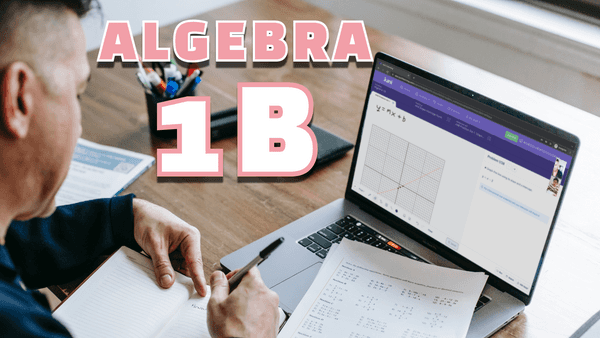Algebra 1A
Algebra 1 teaches linear and quadratic equations and is a pre-requisite for Geometry. We all remember getting stuck on math problems or being eager to skip ahead. Give your child the opportunity to work at their own pace and learning style with a 1:1 instructor.

- Private 1:1
- Format
- Age 12-15
- Learners
- Weekly
- Classes
- 50 minutes
- Per class

About this Course
Billing
Billed as
$275 / month
Scheduling
1:1 classes are 50 minutes long and can be scheduled anytime Monday-Sunday from 7am to 7pm PT. To begin, select Book your Placement Class to signup. Our team will then match you and set up your first class!
- Course duration4-6 months
- Lesson50 minutes
Learning Targets
Algebraic Properties
Algebra-1: The student can define a variable.
Algebra-2: The student can tell the difference between equations and expressions.
Algebra-3: The student can write an equation that models a real world scenario.
Algebra-4: The student can solve an equation using the guess and check method.
Algebra-5: The student can determine if an equation is balanced.
Solving Linear Equations
Solving-1: The student can isolate a variable in a single step using addition or subtraction.
Solving-2: The student can isolate a variable in a single step using multiplication or division.
Solving-3: The student can isolate a variable in a single step using exponents or roots.
Solving-4: The student can solve multi-step equations by isolating the variable.
Solving-5: The student can solve single-variable inequalities by isolating the variable.
Solving-6: The student can solve solve multivariable equations by writing one variable in terms of the other(s).
Solving-7: The student can solve for one variable in a multivariable equation when the value of the second variable is given.
Slope and Rate of Change
Graphing-1: The student can identify the x and y axes on the coordinate plane.
Graphing-2: The student can plot points on the coordinate plane.
Graphing-3: The student can find points on a line given its linear equation.
Graphing-4: The student can graph a line given its linear equation.
Graphing-5: The student can define slope.
Graphing-6: The student can calculate the slope of a line given two points on the line.
Graphing-7: The student can calculate the slope of a line given its linear equation.
Graphing-8: The student can determine if two lines are parallel.
Graphing-9: The student can determine if two lines are perpendicular.
Graphing-10: The student can write the equation of a horizontal line.
Graphing-11: The student can write the equation of a vertical line.
Linear Forms
Forms-1: The student can write a linear equation in slope-intercept form given a point on the line and its slope.
Forms-2: The student can write a linear equation in point-slope form given a point on the line and its slope.
Forms-3: The student can convert between the three linear forms.
Forms-4: The student can write a linear equation in slope-intercept form given the graph of the line.
Forms-5: The student can write a linear equation in point-slope form given the graph of the line.
Graphing Inequalities
Inequalities-1: The student can graph single-variable inequalities on a number line.
Inequalities-2: The student can graph multivariable inequalities on the coordinate plane.
Inequalities-3: The student can write an inequality given its graph.
Inequalities-4: The student can write and solve an inequality based on a word problem.
Solving Linear Systems by Graphing
Graphing-1: The student can solve a system of linear equations by graphing.
Graphing-2: The student can identify special cases when graphing systems.
Graphing-3: The student can solve a system of inequalities by graphing.
Graphing-4: The student can solve a system of equations given a graph.
Solving Linear Systems by Substitution
Substitution-1: The student can solve a system of linear equations by substitution.
Substitution-2: The student can identify special cases when solving systems by substitution.
Substitution-3: The student can write and solve a system of equations based on a word problem.
Solving Linear Systems by Elimination
Elimination-1: The student can solve a system of linear equations by elimination in one step.
Elimination-2: The student can scale one of the system equations to perform elimination in two steps.
Elimination-3: The student can identify special cases when solving systems by elimination.
General Mathematical Skills
I can explain what the question is asking for.
I can explain my thinking behind my work.
I check my work carefully during or after I finish a question.
When I am stuck on a question, I show perseverance by trying a new method or asking for help.
When I am stuck on a question, I use what I know to find a place to start.
General Learning Habits
Joyful Collaboration
- I practice listening to my instructor and sharing my ideas to co-create understanding.
- I attempt tasks independently and ask my instructor questions when I need help.
Unlimited Curiosity
- I take ownership of my learning by asking meaningful questions both when I need clarification and when I want to know more about a topic.
Nimble Determination
- I practice resilience when I am frustrated that I have not yet achieved mastery of a new concept or skill; instead of complaining about challenges, I try new approaches and creative solutions.
Invest in Excellence
- I arrive to class on time and prepared to learn, with my computer set up with a strong internet connection.
- I complete my homework on time, and if I cannot complete my homework due to other obligations, I honestly communicate the reasons for late homework to my instructor.
- I do my best to stay present and on task for the whole session. I support my focus by putting away any distracting technology and setting notifications on my device to “do not disturb” mode.
Homework
Instructors will assign students roughly 60 minutes of class related problems at the end of each session. Homework is generally pulled from Juni's curriculum and is meant to complement the class experience and ensure the student continues to learn and grow outside of the session
Pre-Requisites
Completion or demonstrated understanding topics within Pre-Algebra B
Who are Juni’s Instructors?
Our instructors are subject matter experts from top US universities. Instructors are highly-vetted and background checked prior to joining and undergo extensive training before ever teaching on our platform.
Upon signing up, parents are asked a series of questions that allow us to match your child with an optimal instructor based on their unique needs and interests. Factors that are considered in our matching process include Learning Style, Personality, Personal Experience, and Academic & Career Aspiration.





